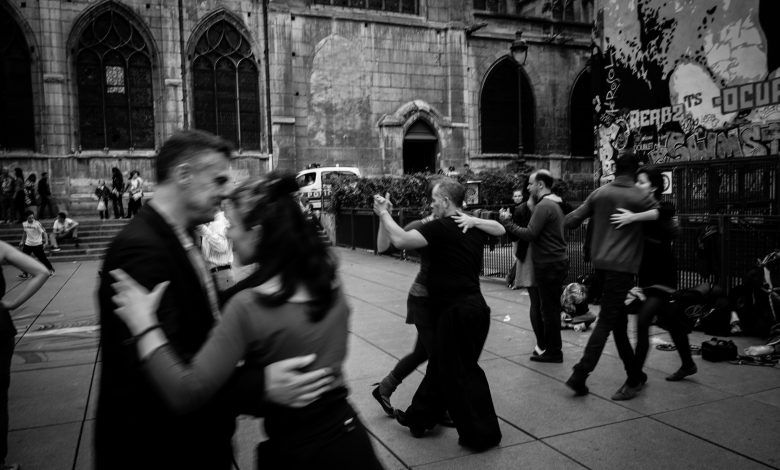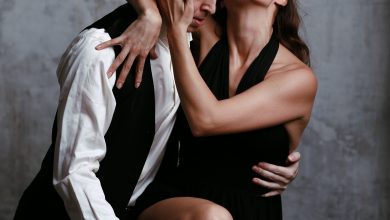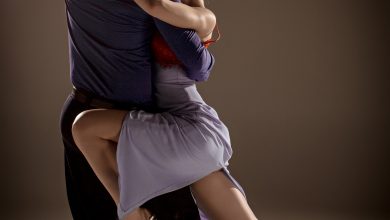The Molinete (or Giro) and the Media Luna

The Molinete / Giro is an extremely important move in Argentine Tango and is one of the most flexible figures because it has so many variations. Basic versions are a fundamental step for beginners and the molinete variations are even more important for intermediate and advanced dancers.
The word Molinete is translated as Windmill in English. It is a figure where the follower makes a sequence of very specific steps, similar to a grapevine, around the leader. The Spanish term Giro (meaning “turn”) is also sometimes used instead of the word Molinete. The Molinete can be danced either clockwise (toward the closed side) or counterclockwise (toward the open side) around the leader. When a half-molinete (medio giro) is danced and the direction is reversed at the end, usually with a front ocho, it is typically called a Media Luna (half moon).
The Follower’s steps are a repeating sequence: Forward step, then pivot, side step then pivot, back step then pivot, then to the side. The leader may decide to begin this sequence at any point, as well as decide when to end it, which of course results in many variations. The following video shows the foundational molinete:
Molinete con cambio de sentido en paso lateral
This is the classic Molinete that every follower beginner starts with – dancing a box or circle around the leader. It is important to make every step equal length in order to complete a 360 degree square.
Entering the Molinete should be straight forward because the leader can start with the follower’s side step or front or back cross as in the start of a front or back ocho.
Exiting a Molinete is also straight forward, but the exit can be more difficult on the quick steps if a quick-quick-slow-slow timing is used. Specifically, the leader should not try to stop the Molinete on the back-side steps. Here are four exits that are the most common:
- Turning front step into front ocho works well in both clockwise and counterclockwise Molinetes. You can use a parada after the front ocho. reasons.
- Counterclockwise front-side step. If the leader steps to the left as the follower completes a front- ide, this is exactly the same as the side step in the tango basic eight. Do whatever you might do from the basic eight side step.
- Counterclockwise front-side step. If the leader rotates the follower a quarter turn counterclockwise at the end of the front side, it is straight forward to just walk to the cross as in the basic eight.
- Clockwise front-side step. You’re already halfway thru an Ocho Cortado; just lead the follower into a snap cross.
There are a variety of technique problems that can occur during the Molinete that should be pointed out:
Leader technique:
- Chest. The lead is initiated by the leader’s chest rotating slightly ahead of the follower. This feels like moving your shoulder back to make room for the follower.
- Initial Lead. The most important part of the Molinete is the initial lead. The leader needs to be quite clear on how the follower should begin their first front or back step. At that point, most followers will know the Molinete sequence so only a light lead is required from that point, and it’s only necessary to indicate deviations from the pattern and to clearly lead the exit.
- Invite. The leader gives a slight invitation (very light pull) in the direction of the turn. The leader should not push the follower.
- Dissociation. The leader is likely to need substantial dissociation of their chest to stay connected to the follower.
- Leader footwork. There are a number of variations to the leader’s steps. A good approach is to place one foot around behind the other in the direction of the turn and then pivot on both feet, repeating as necessary. A simpler, but less attractive, solution is to make many small wedge shaped “penguin” steps to rotate.
Follower technique:
- Around. The follower’s steps should be around the leader, not away. Moving away will likely destroy the nice tall posture of one or both partners.
- Ankles close. Pivots should be made with the ankles close together.
- Big pivot. The follower needs to pivot quite far. The pivot following the side step is especially demanding (180 degrees).
- Timing. The front then pivot and side then pivot often need more time than the back and side steps, therefore it is sometimes danced as slow (front then pivot), slow (side then pivot), quick (back), quick (side).
- Dissociation. Follower should dissociate, keeping their chest facing the leader as much as possible.
- Balls of feet. Stay on the balls of your feet, chest forward. Be especially careful to stay forward on the back step. Heels should not touch the floor.
- Who is supplying the turning power? Initially it is the leader that is providing the leading impulse to move the follower. However, there is a point in the series of Molinete steps where the follower is actually supplying the energy for the leader to turn to face the follower.
When first learning the Molinete, a Tango teacher may actually start by teaching the Media Luna because it’s only half of a full Molinete. This is much easier for the leader as it doesn’t require as much leader footwork while they are learning to clearly lead the follower.
- Videos of the Media Luna (Half Molinete with return)
Clases de Tango – Figura 6 La Media Luna
Gabriel and Carolina. Clockwise from mirrored back crosses.
How to Do the Grapevine | Argentine Tango
With Diego Blanco and Ana Padrón. Clockwise starting from the cross. Reverses direction to return to facing. Then shows it from mirrored back ochos, reversing direction on the front ocho.
Media Luna by Ricardo and Raquel
This Media Luna ends, as many do, with a parada, but it’s different from most because that the parada is behind the follower’s foot.
By LA Tango Academy. Nice Media Lunas ending with Ocho Cortados. Leader steps across and pivots 180 degrees.
Videos of the Full molinete. When doing a full molinete, or multiple Molinetes, the leader must do more footwork to keep turning.
Tango with Lori & Patrick – Molinete, leader’s technique
Molinete in parallel and cross system (staring with back ocho). Leader steps with every follower’s step. Media Luna and full Molinete.
By James & Joanna. After a simple lesson on the Basic Eight, this gives a standard demo of a basic Molinete with instruction.
Osvaldo y Mora.See how he keeps his chest moving and always facing the follower. Clockwise from back ocho.
Oscar Caballero and Roxana Garber. Counterclockwise from Americana.
Clases de Tango – Figura 4 El Molinete
Gabriel and Carolina. In Spanish. Explains leader’s footwork (in Spanish) as left behind with pivot.
Beginner Argentine Tango Class Notes (Figures)
By TangoCalgary. This compilation of moves includes a molinete. The follower’s footwork is standard, but the leader’s footwork is interesting.
Full Turns – 360 (or Molinete)
There are three types of Tango Turn
Very Open Turn
Very Close Turn
Relative Turn
The difference between Absolute Turns and Relative Turns is that Absolute Turns do not change the axis, it stays in one position. During Relative Turns, the axis shifts (for example when the Leader does a Sacada).
The Very Open Turn
When dancing in open embrace, both dancers are on vertical axis, straight up and down.
The Follower should step long to help the success of the movement.
The goal of both Leaders and Followers is to make the turns clean.
Follower’s exercise:
Leader in the middle
Follower brings arms up and does turn/hiro/molinete footwork around the Leader, starting with her inside foot and doing a forward step.
So her footwork is:
Forward
Side
Back
Side
Forward
The Follower should control their back before stepping back. The back step needs to be made with control.
The side step finishes where the Follower starts
For the side step, the Follower should reach first, then power into the floor to get a big pivot on the next step. Follower should lengthen the sides, make the spine long, and use the floor to power the pivots.
In the back step, the follower can do more of a back cross step across the body, instead of a straight back step.
Molinete Exercises for Followers:
Work on the 3-point turn (Forward, Side, Back), starting in front of the Leader and trying to end there, making just three steps to get all the way around the Leader. The goal of this exercise is for the Follower’s to get used to taking long, reaching steps, but still keep the circle small and close to the Leader.
• Follower should hold arms out, making sure shoulder blades come together and using back muscles.
• Follower should try to be close to the Leader and not float away with any of the steps.
• Side step is long and reaching in front of the leader in the center.
• Follower should create reach first.
• The dynamic change of weight is at the pivot as hip swings around.
• Back step finishes where follower starts
• The Follower’s steps are all done with control.
• Follower should not fall to the side, otherwise will pull the Leader and will be ahead of the turn.
• Follower should hang back a little to keep the circle more stable.
Leaders Exercise
• Turning in a block as the Leader is the center of the circle
• Disassociation (send chest first, then hips come around as a consequence, and exceed where chest is)
• Cross forward steps, while walking back
• Back cross
steps, while walking forward



